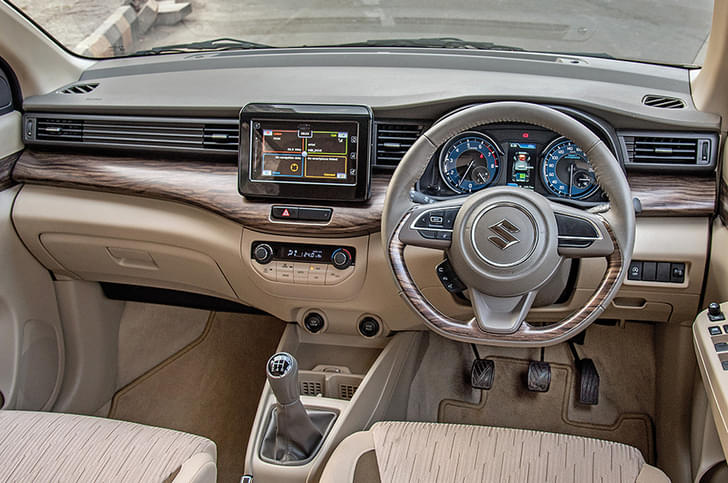For its sheer versatility and value for money, the first-gen Maruti Suzuki Ertiga set off to a flying start when it launched in 2012. Over the years, however, its sales witnessed a few troughs due to the shift in buyer preferences towards other segments like compact sedans, premium hatchbacks and SUVs. Despite that, this seven-seater from Maruti soldiered along with steady sales (a major contributor being the taxi market), and even towards the end of its life cycle it averaged over 3,500 units per month, which is quite respectable. But now, there’s an all-new, second-generation Ertiga, and if initial impressions are anything to go by, this one is far more desirable and a much better package than the one it replaces.
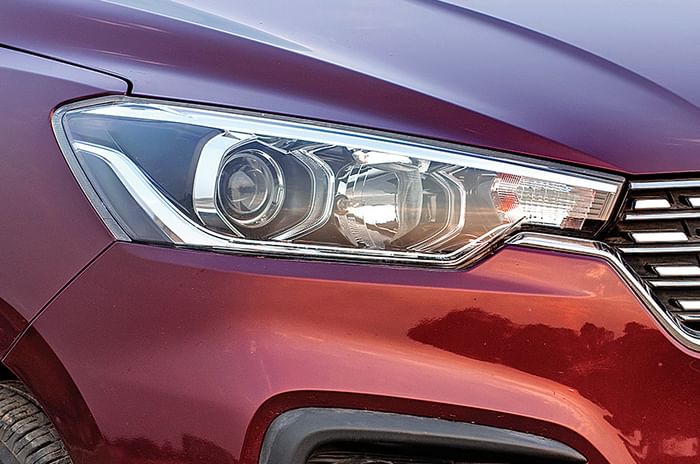
Built on an all-new platform, the second-gen Ertiga is larger in every dimension, and, as a result, is more spacious than before. It comes with two engine options – an all-new 105hp, 1,462cc petrol, and the tried and tested 90hp, 1,248cc Fiat-sourced diesel. Both engines are mated to 5-speed manual transmissions, with the petrol also getting a 4-speed automatic in the form of a traditional torque converter. A petrol-CNG and an all-new in-house developed 95hp, 1,498cc diesel engine are likely to join the range soon.
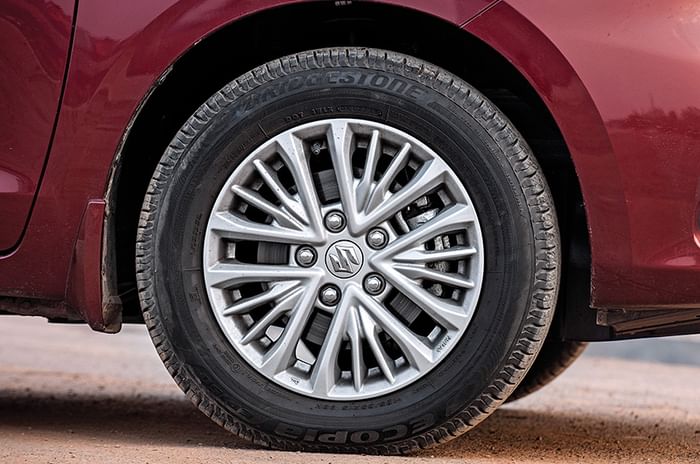
The petrol Ertiga’s pricing is very aggressive at Rs 7.44-9.50 lakh for the manual and Rs 9.18-9.95 lakh for the automatic. And at this price point in the rather uncrowded MPV market, it doesn’t have any direct competitor. At Rs 8.84-10.90 lakh, the diesel-manual is a bit pricey, especially considering the Rs 1.40 lakh premium it commands over the petrol but it still undercuts its core rivals – Mahindra Marazzo (Rs 9.99-14.38 lakh) and Renault Lodgy (Rs 8.63-12.12 lakh) by a significant margin. So it is still a value-for-money proposition, but what’s improved from the first-gen model? We put it through our thorough test to find out.
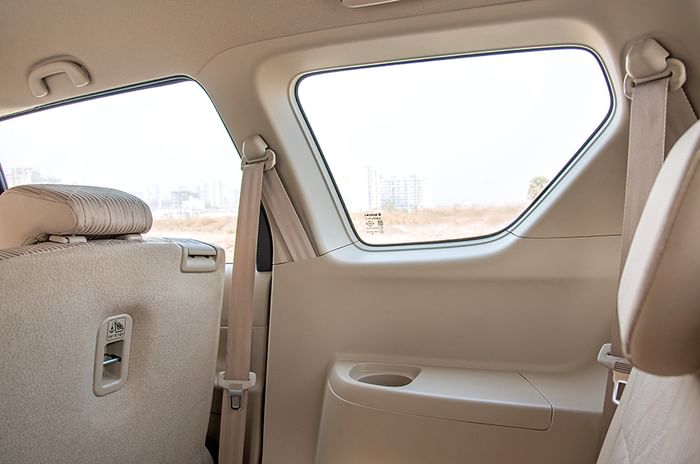
This second-generation Ertiga is based on the same Heartect architecture as the new Swift, the Baleno, Dzire, Ignis and the new WagonR. Despite being lighter in weight, its structure is stronger than before to meet the tougher crash norms that come into effect this October. It also boasts better torsional rigidity, which has a positive impact on refinement and dynamics. And even though this car has grown significantly larger than its predecessor (by 130mm in length, 40mm in width, and 5mm in height), the overall kerb weight has gone down by 20kg across variants. At 2,740mm, its wheelbase remains identical to the older car, while the front and rear track have increased by 30mm.
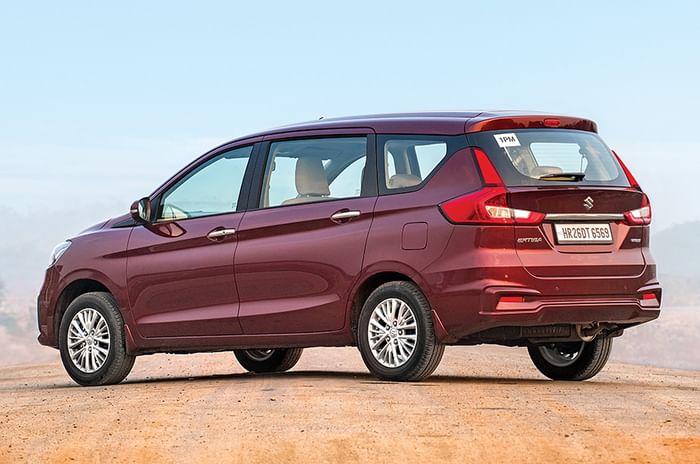
While the outgoing car appeared like an elongated Swift with a rather bland, van-like side-profile, the new one looks far more handsome and desirable. Its headlamps bear an uncanny resemblance to the Toyota Innova’s, but in spite of that, the Ertiga has a distinct identity of its own. The chrome-studded grille looks tasteful and makes a great first impression, while the bonnet is more sculpted and has gained some muscle with sharper lines. The side profile too boasts a more prominent waistline but the wheel arches aren’t as pronounced as before and the 15-inch multi-spoke wheels look a bit ordinary. Its side profile also features a design element that’s now common on several modern Marutis, where the window line merges with the rear windscreen, resulting in a floating roof-like impression. The rear of the Ertiga is rather interesting, with ‘L-shaped’ tail-lamps reminiscent of the Volvo XC60. And the overall design of the concave tailgate, the chrome applique and the horizontal tail-lamp sections, appear identical to that of the Ciaz.
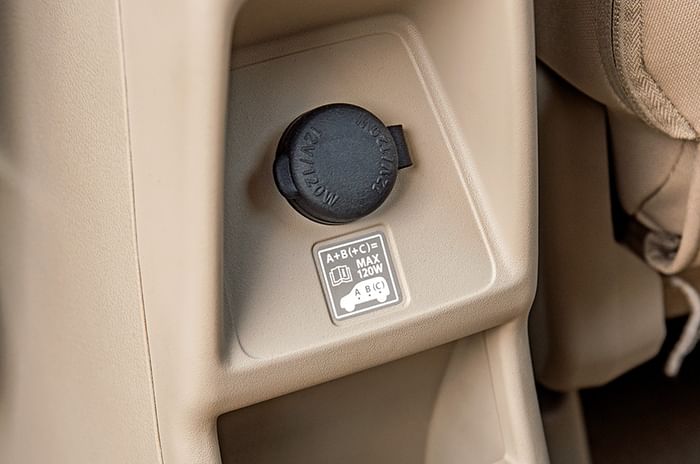
The older Ertiga’s interiors were functional and rather drab, but the new one takes a huge leap forward in terms of design and quality. There are Audi-like air vents running the breadth of the dashboard, along with the artificial wood trim – both of which feel like imitations – but these somehow seem to up the cabin’s upmarket quotient. Even the free-standing touchscreen and the flat-bottom steering blend in nicely with the other design elements. Plastics in the cabin are hard but quality for the most part is a big step up. A lot of switchgear is shared with modern Marutis and they feel nice, but many bits like the power window switches, cabin lamp and the flimsy bonnet opener have been carried forward from decade-old models.
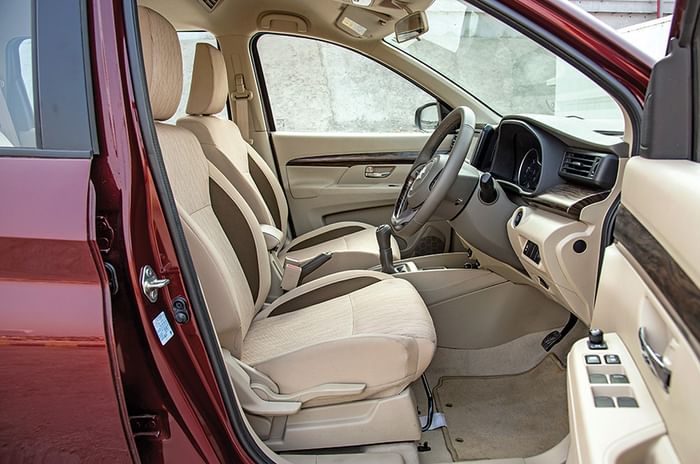
The new Ertiga is very user-friendly when it comes to ingress-egress, with a tall stance and wide-opening doors, so passengers can simply walk into the car, without the need to crouch or climb in. The front seats are broad, supportive and the cushioning is spot on – full marks to Maruti when it comes to seat comfort. Even the seating position is very car-like, albeit a tall car, so drivers get a good view of the road ahead due to the high seating position and large expanses of glass all around. Storage areas are aplenty, and the air vents in the front cupholders are unique – these channel cool air from the air con directly to the beverages placed here. However, some areas like the glovebox and the armrest console are a bit too small.
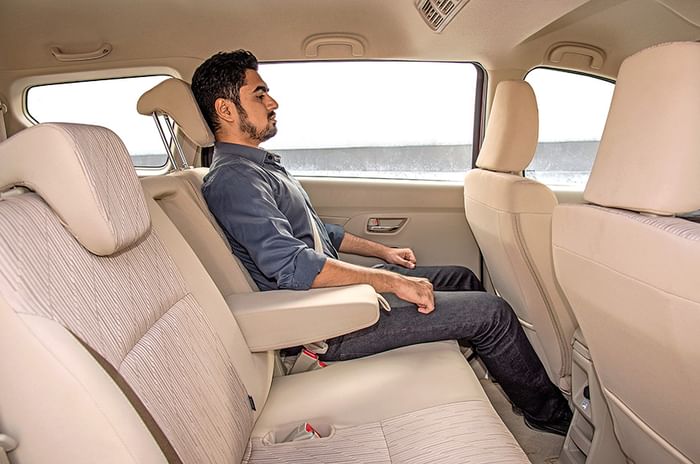
Those seated in the middle can enjoy the view outside via the massive windows, which also flood the cabin with light. However, a sun-blind (like in the Marazzo) would have been a nice addition. The seat itself is very comfortable and supportive, and room here is huge with the seat slid all the way back. Headroom here isn’t a concern either and the seat even reclines to a very comfortable angle in a 40:60 ratio. The occasional third passenger here will be quite comfortable now thanks to an almost flat floor and a bit more shoulder room, which is a result of the car’s wider dimensions. To keep the passengers seated here cool, there’s a roof-mounted blower; and there’s also a 12V power socket in each row, however there should have been the more modern USB charging slots.

Getting into the third row isn’t as easy as in the other two rows, as the (kerb-side) middle-row seat slides ahead with the tug of a lever but doesn’t tumble forward, freeing up just enough room to duck-walk your way into this space. What’s surprising is that room here is adequate, much more than the car’s exterior dimensions suggest. The large windows and beige all around further accentuate its airiness. And then, the seats, although a bit low-set, are comfy, with a good amount of head and shoulder room on offer for two adults. Kneeroom too, is adequate, and the seat even reclines to a comfy angle; so adults can sit here on long drives without losing circulation in their legs. However, in the reclined position, their heads will brush against the roof. Conveniences for the last row include a large side armrest, bottle holders and one charging socket. At 209 litres, the boot is larger and more practical now, and it also gets a nifty storage area beneath the boot floor that can easily swallow a few laptop bags. Folding the last row gets you 550 litres, and folding the last two rows gives you 803 litres of cargo volume.
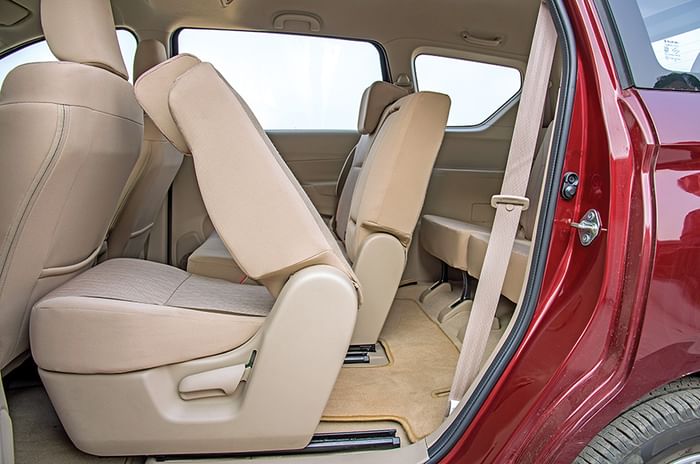
The new petrol engine is very similar in character to the older 1,373cc unit that it replaces. Throttle responses are sharp, and the gear ratios are so well judged that the motor builds speed cleanly from lower down the rev range. The ease with which the Ertiga petrol pulls on an incline from 20kph in third gear with a full load of passengers is quite impressive. As long as you aren’t in a hurry, the motor does the job smoothly and silently. Dab the accelerator by 10 or 20 percent, or even under high load, an animation on the MID screen shows the battery providing some additional power to the petrol engine – this is done to improve its responsiveness. While this electric boost from the secondary Lithium-ion battery isn’t pronounced, a crisper throttle response surely is. Performance in the mid-range is flat and lacklustre, although beyond 4,000rpm, there’s a small bump in performance that remains strong until the redline. With the needle swinging to the far side of the tachometer, the engine is quite vocal, which is a contrast to its otherwise silent and refined character. The added 13hp and 8Nm of torque result in superior acceleration timings. 0-100kph is dispatched 1.46sec quicker than the older 1.4-litre petrol, and even within gears, the new 1.5-litre is quicker from 20-80kph and 40-100kph in third and fourth gear by 1.14sec and 1sec, respectively.
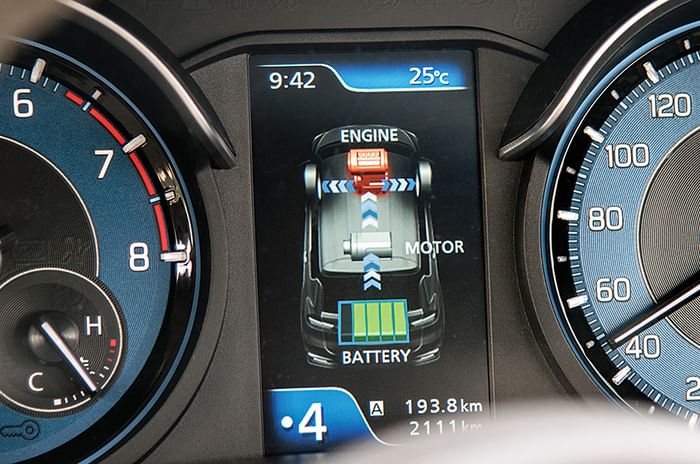
The petrol-automatic uses a 4-speed torque converter, with the first three gears being driving gears and the fourth being an overdrive gear. It is very smooth, the shift-logic is quite sorted and, for the most part, it does the job just fine. It’ll also shift to the highest gear at the earliest to aid fuel economy. Be gentle on the accelerator and it won’t downshift easily, and will try and build speed in the existing gear. Ask for more power though, and it’ll drop down a gear (or two) to get a move on, but with an increase in revs (from as early as 3,000rpm), the engine gets rather louder and louder as you pile on the revs. While driving in a hurry, there’s an ‘overdrive off’ function that ensures the gearbox will remain only in the first three gears, thus keeping the engine on the boil. There’s no manual mode but there’s a Low mode that locks the lowest possible gear, which is useful for uphill sections of road and/or to control the engine speed while going downhill, and also gives drivers the option to remain in second gear. Also, because the gear lever gate is straight, it’s very easy to slot into second gear or even ‘L’ rather than ‘D’ accidentally (especially while parking), and this requires some attention, while starting off from a standstill.
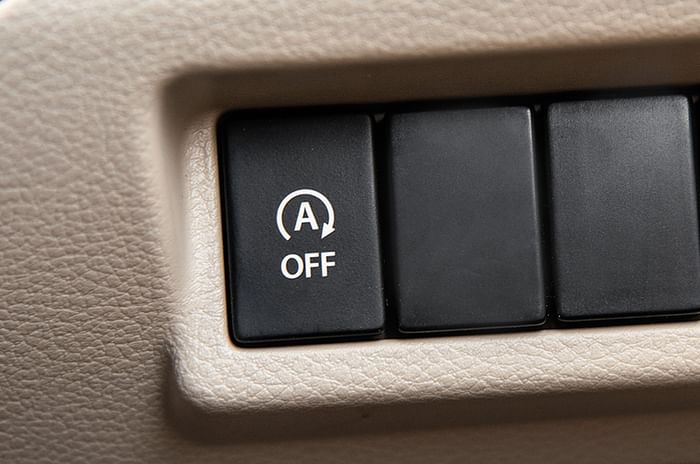
The Fiat-sourced 1.3-litre diesel engine remains unchanged, on paper at least. Get behind the wheel, however, and it feels a bit easier to drive and lighter on its feet compared to before. Turbo lag below 2,000rpm isn’t as significant and even when the boost comes in, it does so in a more linear manner. The meat of the powerband remains between 2,000 and 3,500 rpm, although the older car felt stronger until 4,000rpm before the power began to taper. The diesel is still an able highway cruiser, and as long as you’re driving within the powerband, overtaking feels effortless. Fall below 2,000rpm though and it still warrants a downshift to make rapid progress or make a quick overtake, and bigger speed-breakers still need to be taken in first gear only. While acceleration timings remain near-identical to the outgoing car, 40-100kph in fourth is now a significant 1.3sec slower, although it’s interesting to note that the fourth gear ratio is identical to the older car. What really let’s this motor down, however, is the hoarse engine note at idle. The engine clatter smoothens out once on the move, so when driving around at city or cruising speeds it feels fine, spin it harder, though, and the gravelly note gets louder and sounds unrefined as the revs build.
The petrol’s clutch is lighter than the diesel’s and the 5-speed manual transmission mated to both the engines is slick-shifting with short and precise throws.
One of the stand-out features of the new Ertiga is its ride quality. It’s so good and well behaved, it smoothens out potholes and broken roads like a much more expensive car. There’s no rocking or side-by-side motion over broken patches either. At high speeds, it rides flat with some vertical movement from the rear, but it’s never excessive. With a full load of passengers, however, there’s noticeably more pitching, and the softer rear suspension takes a couple of rebounds before regaining composure when going over humps or wavy surfaces.
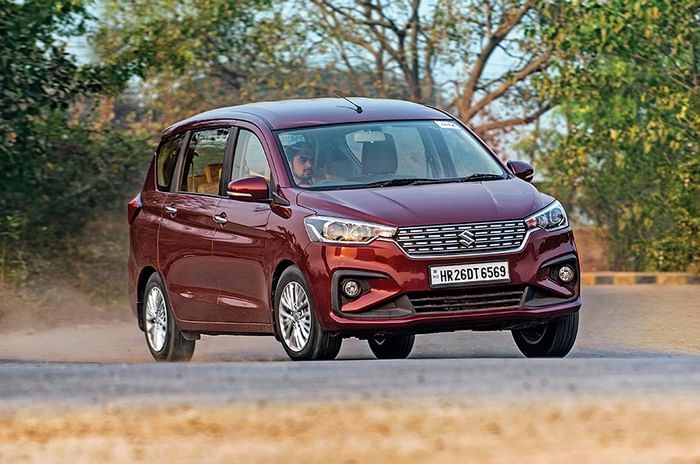
The new Ertiga’s wider track and tauter chassis give it a lot more composure and poise while taking corners. Push it hard and even though body roll is present, it’s not more that a tall hatchback. It turns into corners sharply and while it is not as nimble as a Swift in the way it changes direction, it still is a confident handler. Further adding to driver confidence is its steering, which is unlike any Maruti based on the same Heartect platform – it has a nice heft to it, it feels connected to the road and returns to the centre without any effort. The Ertiga’s steering is the best yet on a new Maruti and that’s saying a lot when you consider it’s an MPV!
The Ertiga petrol-manual’s auto start-stop feature works so quickly and so seamlessly that, on cooler days especially, one wouldn’t mind extracting the benefits of this feature (saving fuel while stationary) by leaving it on. In the city, this motor returned merely 9.5kpl, which is 0.7kpl lesser than the 1.4-litre unit. On the highway, however, it managed a healthy 16.8kpl, an improvement of 4kpl, due to a taller fifth gear.

With a city efficiency of merely 7kpl, the petrol-automatic isn’t for the fuel efficiency-conscious. But having a very tall fourth gear helps while cruising on the highway where it returned a respectable 15kpl; still far from its claimed 18.69kpl though.
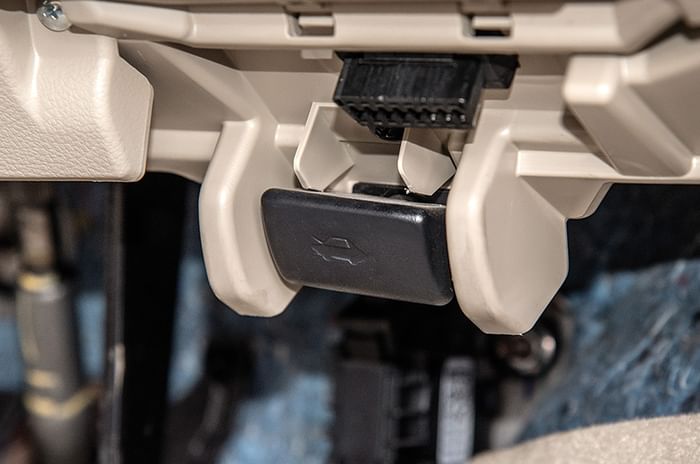
The diesel’s gear ratios remain identical to the outgoing car, however, some engine tweaks have resulted in 15.2kpl in the city and 19.4kpl on the highway, an improvement of 0.4kpl and 2.6kpl, respectively.
Maruti’s covered all the essentials with the Ertiga. So it gets ABS with EBD, dual airbags, speed-sensing door locks, child seat mounts (middle row), and rear parking sensors right from the base variant, and even projector headlamps, 50:50 split recline third row and a 60:40 split middle row, power windows and central locking are standard across the range. As you go higher up, it gets kit like electric-folding mirrors, 15-inch alloys, steering-mounted controls, rear wiper and washer and automatic climate control, among others. The top spec gets a touchscreen with Android Auto and Apple CarPlay, and a reversing camera. The petrol-automatic isn’t available in the top-spec, but what it gets is ESP and hill-hold assist.

The Ertiga could have done with some more kit like cruise control, LED DRLs, larger wheels and wider tyres, rain-sensing wipers and rear sun-blinds, all of which its direct competitor, the Marazzo, gets. However, factor in its aggressive price tag and Maruti can be excused for the missing kit.
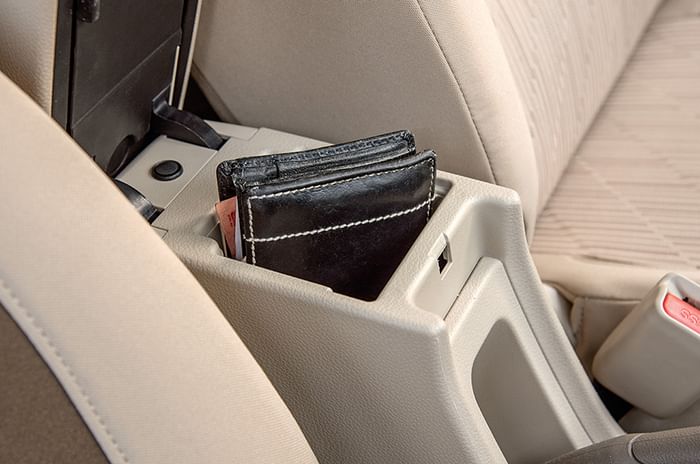

The 7.0-inch SmartPlay infotainment system is equipped with SD card-based navigation, Mirrorlink, Android Auto and Apple CarPlay. This system is easy to use, and the display is crisp with sharp contrasts. The system’s software lags at times and its slow responses can get annoying while on the move. While the menu buttons on the sides are touch-operated too, the volume rocker isn’t the most convenient to use. Voice commands are available, and are quite accurate most of the time. Sound quality from the 6-speaker setup (four speakers and two front tweeters) is quite decent. The camera engages with a small delay, when the car’s put in reverse.
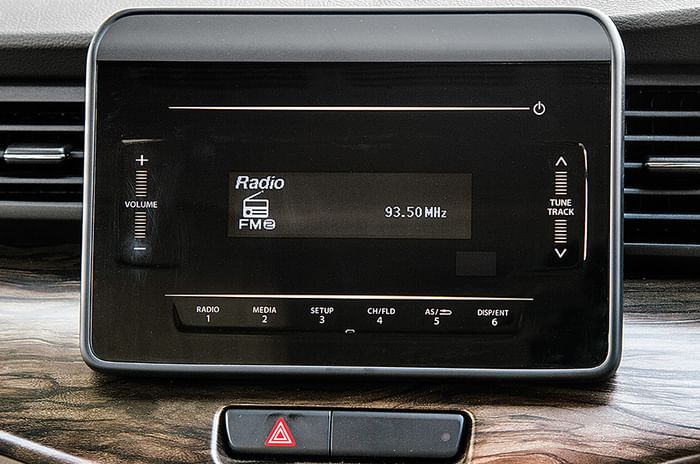
Maruti has nailed it with the new Ertiga’s clever packaging. Despite being a seven-seater, it is still compact in dimensions, and its light controls and good all-round visibility make it very user-friendly and easy to drive. The interiors are more spacious and feel plusher, and the well-cushioned seats take cabin comfort up a few notches. What’s more is that the larger cabin and the backrest recline function has made the third row far more usable now. The new petrol engine is smooth, refined and performance is adequate, and paired to the manual, it’s our pick from the range; the automatic is heavy sipper in the city, while the 1.3-litre diesel, although easier to drive (than before) and very efficient, feels a bit crude. The Ertiga does miss some features but its pricing is so aggressive, you just can’t argue with its value proposition. At the end of the day, this isn’t an exciting car that’ll tug at your heartstrings, but it is one that’s very practical and delivers all that’s expected of it and rather competently. So when it comes to fitness for purpose, the Ertiga passes with flying colours, and it’s for this very reason it was our Car of the Year 2019.



